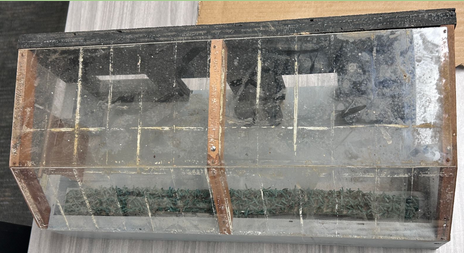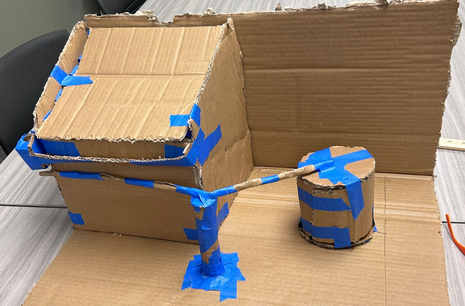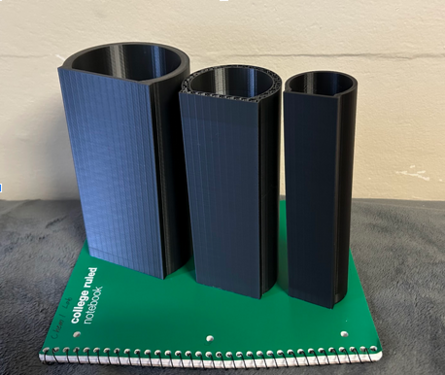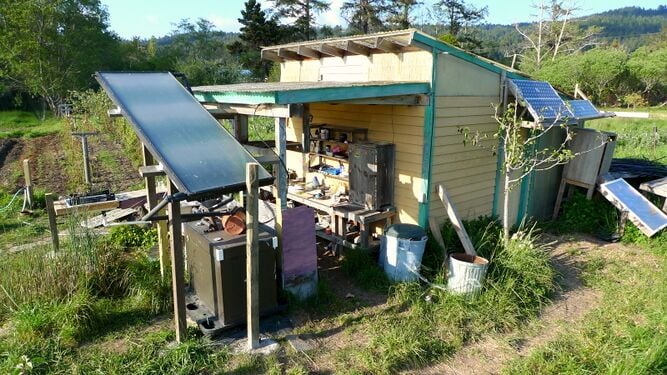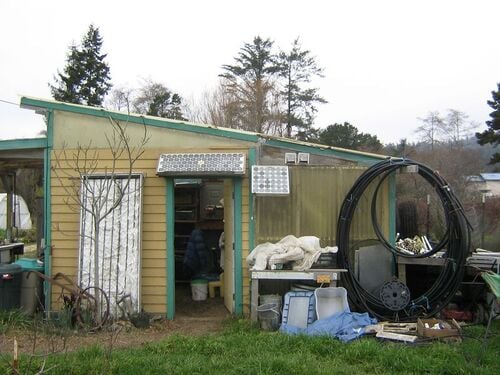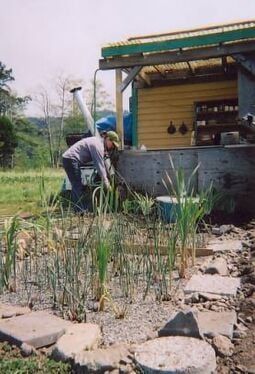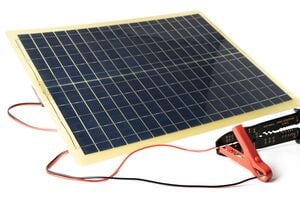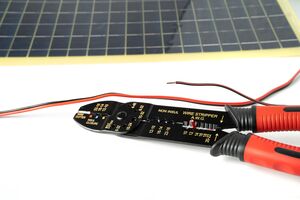
This paragraph will appear in search results and previews for this page. Write a brief introductory text with information such as a description of your project, when was it designed and built, your motivation to solve the problem, the intended users. This will explain your project to someone who has never heard of it before.
Inspiration[edit | edit source]
Campus Center of Appropriate Technologies (CCAT) is a student run community based organization located at Cal Poly Humboldt University dedicated to teaching students as well as local community members about appropriate technologies and ways of life. As an engineering design class at Cal Poly Humboldt 2024, CCAT requested the engineering 205 students help with their on sight projects. This includes the rainwater harvesting models installed and operated at CCAT. The student leaders found that it was hard to teach people about all the components of their rainwater harvesting systems because of location and large size of the systems. This led to CCAT's request for a model to help demonstrate the effectiveness of rainwater harvesting systems at tabling events. They wanted a model that both accurately functioned like a rainwater harvesting system, and that was able to effectively demonstrated each component to educate spectators and community members.
Guiding Statement[edit | edit source]
The objective of this project is to design and construct a scaled-down model of a custom designed rainwater harvesting system. A primary objective is for the model to accurately demonstrate the functions of a rainwater harvesting system. It should also effectively work as an educational demonstration tool to help CCAT visitors visualize and understand how rainwater harvesting systems function.
Criteria[edit | edit source]
Below are the criteria we set as measurable and quantifiable objectives to be used to judge the quality of the model.
| Criteria | Description | Weight (1-10) |
|---|---|---|
| Level of embedded Energy | Reusing materials to minimize waste. | 6 |
| Aesthetic | The model must be aesthetically pleasing as it needs to be educational. | 9 |
| Ease of Use / Functionality | It must be easy for CCAT to use or else it would make demonstrating it a burden. | 8 |
| Educational | It must be educational or else there is no point on having the model. | 10 |
| Realistic/Relevant | It must be realistic for it to represent a real life rainwater catchment system. | 7 |
| Longevity | The components of the model should last for a long period of time to minimize repair cost and waste. | 7 |
| Portability | It must be portable as it is going to be carried to events . | 10 |
Prototyping[edit | edit source]
The first prototypes came in the form of cardboard models in an attempt to understand the sizing of the model in relation to storage restraints and the layout of the individual pieces. At some point during the prototyping process the team was given a model of the CCAT greenhouse to be incorporated into our design which required a change of plans in the layout and sizing process.
- Sample gallery
-
Image of the original greenhouse component.
-
Cardboard prototype of the model layout.
-
3D print of different sizes of cistern.
Final product[edit | edit source]
Our final product ended up incorporating the modified greenhouse and was assembled in generally the same layout as the cardboard prototype above. The greenhouse was cut in half and given new plexiglass. A 3D printed gutter was attached to the roof which leads to the filter, which then goes to the first flush and then to the cistern.
IMAGES Construction[edit | edit source]
IMAGE FOR THIS The rainwater catchment system was built on top of a 24x15.5 inch piece of wood. Each component is held in place with screws through the bottom. The greenhouse uses components from a leftover, unused greenhouse model given to us by CCATT. The greenhouse has support beams inside holding the plexiglass roof in place. The gutter is then connected to the plexiglass roof where it then connects to the rest of the system. The system is connected by 1/4 in tubes that feed water into each component. The first flush is connected in a way where it can be easily taken off to be cleaned and emptied; similar to the cistern.
- Sample gallery
-
Sample caption text.
-
More sample caption text. This would look better with different images.:)
-
Even more sample caption text.
NEED TO MAKE VIDEO Video instructions[edit | edit source]
Here is a video instructing on how to use the rainwater catchment system.
Bill of Materials[edit | edit source]
Here are the costs of all materials broken down into simple components.
| Item | Amount | Cost per unit | Total |
|---|---|---|---|
| Plexiglass | 3 | USD 25.00 | USD 75.00 |
| Waterproof Paint | 1 | USD 25.00 | USD 25.00 |
| Decorations | 1 | USD 35.00 | USD 35.00 |
| Nails/Screws/Glue/Other misc. materials | 1 | USD 35.00 | USD 35.00 |
| 3D printed components | 3 | USD 1.00 | USD 3.00 |
| Grand total | USD 173EUR 148.78 <br />GBP 126.29 <br />CAD 214.52 <br />MXN 3,607.05 <br />INR 12,949.05 <br /> | ||
IMAGES Operation[edit | edit source]
Below are the steps needed to operate the rainwater catchment model. It is simple to use and can be easily taught to others.
Maintenance[edit | edit source]
The rainwater model catchment does not need much maintenance as it is durable and made to last. Some maintenance will be needed to insure the longevity of the model. These actions should be performed by members of CCAT and should be done semi-regularly.
Maintenance schedule[edit | edit source]
Here is a break down of what should be done to upkeep the model over time.
- Daily
- No need for daily maintenance.
- Weekly
- Dust model as to not cause a build up of debris.
- Monthly
- Check for any (water) damage after each use.
- Yearly
- Check pipes to make sure there are no leaks.
- Reapply waterproof paint if necessary.
- Every 3 years
- Replace any parts that are broken or need to be replaced and reapply waterproof paint.
Conclusion[edit | edit source]
Testing results[edit | edit source]
The model was tested by introducing water into the system and seeing how well it was able to flow through each component. The effectiveness of the filtering aspects can be assessed by observing the cleanliness of the water after being run through the model.
Discussion[edit | edit source]
The testing results provide valuable insights into the performance and functionality of the model to replicate the abilities of a real rainwater catchment . By introducing water into the system and observing its flow through each component, we were able to evaluate the functionality of the model's filtering aspects and its ability to output clean water.
Lessons learned[edit | edit source]
If the project were to be done over again we would've probably started prototyping and getting in concrete work earlier on so that we could encounter issues and reevaluate our plans with ample time to redirect.
Next steps[edit | edit source]
The model can hopefully be used in the future as an educational tool for CCAT to demonstrate the functionality of their rainwater catchment system.
We hope that the model will make it easy for people to understand not only the technical aspects but also the more abstract concepts of sustainability and the positive effects of recycling rainwater.
Troubleshooting[edit | edit source]
| Problem | Suggestion |
|---|---|
| Water Leakage | Check connections between PVC pipes
and make sure that each individual piece is properly secured. |
| Water not Filtering | Check that the floating ball in the first flush
has not become stuck. |
Team[edit | edit source]
- ENGR 205 Spring Semester 2024
- Jocelyn Biedler
- Jonathan Hicks
- Aiya Tobin
- Ethan Trojanowski
References[edit | edit source]
